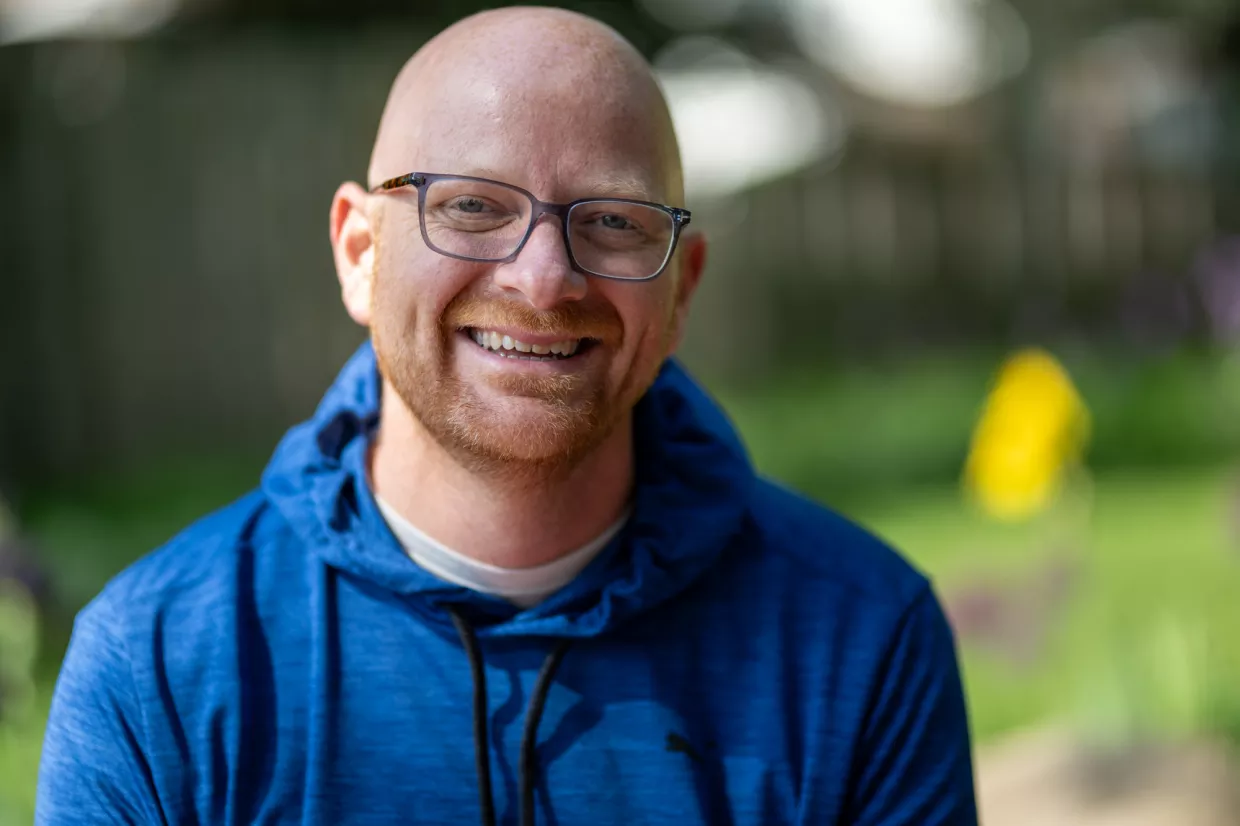Neurosurgery eliminates facial twitch, restores smile
For seven years, a hemifacial spasm took over half of John Mark Feilmeyer’s face. A neurosurgeon at UI Health Care eliminated it.

It started in 2015 with an occasional eye twitch.
“It was that sort of twitch people get when they’re stressed or drink too much coffee,” John Mark Feilmeyer says.
But the twitch then spread from his eye to the entire right side of his face, and it became almost constant.
After seven years of trying various home remedies, getting Botox injections, and seeing a local neurologist, the Des Moines, Iowa, resident asked to be referred to University of Iowa Health Care in Iowa City.
“It was so bad at this point,” Feilmeyer says. “It had been going on for so long and I was just like, ‘Please, somebody help me.’”
That somebody was neurosurgeon Patrick Hitchon, MD, and his team at UI Health Care.
Feilmeyer was diagnosed as having a hemifacial spasm, a condition in which a blood vessel is touching the facial nerve (cranial nerve VII). The blood pulsating through the vessel irritates the nerve, causing the muscles on one side of the face to twitch.
“It’s a bit like a water pipe in your house,” Hitchon says. “Sometimes when you flush the toilet, the pipe vibrates against a wall and creates a rattle. To stop the pipe rattling, you place a sponge between the pipe and the wall.”
To treat Feilmeyer’s hemifacial spasm, Hitchon performed a type of neurosurgery called microvascular decompression. Through a small opening in the skull the size of a quarter, the surgeon inserts a Teflon sponge the size of a grain of rice between the blood vessel and the nerve to keep them from touching.
Before Feilmeyer turned to surgery, he spent years trying less-invasive treatments — including multiple Botox injections.
“The first time I did it, the twitch completely went away, and I thought, ‘Problem solved,’” Feilmeyer says. “I kept going back about every four to six months, but the effect of the Botox was going away.”
Hitchon says this is normal.
“Botox becomes less effective with the passage of time,” Hitchon says. “The frequency needing it goes up, and the effectiveness goes down. This is often when patients start to seek other options for treatment.”
At that point, Feilmeyer says, the hemifacial spasm controlled his life in a lot of ways.
“You don’t want to be vain, but you’re constantly thinking about how you look to other people and how other people are experiencing that. I’d be presenting at work and — especially in those times where I needed to be more performative — it would kick in. I want people to focus on my work, not on my face going crazy on stage. And I think people are very forgiving about stuff like that, but it still happens,” Feilmeyer says.
“It got so bad that it would wake me up in the middle of the night. Even things like driving, or staring at a computer, or trying to concentrate on my work became difficult. I developed some techniques to deal with it, but it was such a huge part of my life.”
During Feilmeyer’s first visit to UI Health Care, a neurologist suggested medication to relax the nerves. Unfortunately, it didn’t help. Having already tried Botox, Feilmeyer was referred to the Neurosurgery Clinic.
“This condition may not be life threatening, but it can be incredibly disruptive to your life,” Hitchon says. “If and when you believe it has reached a certain severity and when all other treatments have failed, surgery may be appropriate.”
Microvascular decompression takes about two hours, and the patient usually can go home the next day.
During Feilmeyer’s surgery, Hitchon discovered that along with a blood vessel affecting the facial nerve and causing the hemifacial spasm, there also was a blood vessel touching the trigeminal nerve (cranial nerve V). While this wasn’t affecting Feilmeyer at the time, it could eventually lead to trigeminal neuralgia, which causes intense facial pain on one side of the face. To avoid this, Hitchon also placed sponges between that nerve and blood vessel.
Hitchon says patients who have microvascular decompression to treat a hemifacial spasm may not see immediate results.
“This is because the nerve has been beaten on by the blood vessel for years,” Hitchon says. “It can take some time for the nerve to recover.”
For Feilmeyer, it took about six months for the twitch to completely go away.
“When I went back for a follow-up five or six weeks after surgery, I was really annoyed because it was still happening. But Dr. Hitchon was sure it was getting better,” Feilmeyer says. “It just kind of drifted off. I was pretty excited when I realized that it hadn’t happened in a few weeks. It was a good feeling.”
Feilmeyer says he did a lot of research before deciding to have surgery and felt confident in the expertise at UI Health Care.
“The thing about getting a craniotomy, and someone going next to your brain stem, is you want to avoid it at all costs,” Feilmeyer says. “But once it was clear that surgery was the ultimate solution, the University of Iowa was an easy place to place my confidence. They’re literally teaching our future doctors. I also got a lot of confidence when searching Dr. Hitchon’s name and finding articles he wrote about microvascular decompression. If anyone knows about it, it’s him.”
Feilmeyer also says he appreciated the support he received at the Neurosurgery Clinic and everyone there who answered all his questions leading up to and after surgery.
Hemifacial spasm only affects about 1 in 10,000 people. Hitchon says because these cases are so few and far between, it’s important to have a team that performs microvascular compressions on a regular basis.
“My skill is not going to be as good if I only do one a year,” Hitchon says. “The more often you do an operation, the more likely that it is going to be successful. It’s like running a race. The more you run, the faster you get, and the more likely you are to win.”
Feilmeyer says he wishes he had sought care sooner at UI Health Care.
“I got the impression from Dr. Hitchon that the longer that you let it go on, the longer it takes to recover,” Feilmeyer says. “I wish that I hadn’t kept putting my hope in the Botox and I had just moved faster to get it done. I think I could have had that improvement in my quality of life so much faster.”
Hitchon encourages people whose lives are being impacted by hemifacial spasm to seek help — and to not be discouraged if they don’t find a solution immediately.
“It’s important for people to persevere and find out the cause of their ailment. Don’t put it on the back burner for too long,” Hitchon says. “The sooner you do investigation, the better. I think we should always be diligent in coming up with an answer for our ailments. And if you don’t get satisfaction from one doctor, see another until you are satisfied that your problem has been diagnosed and treated.”
Meanwhile, Feilmeyer is back to enjoying life without a facial twitch.
“Even a bright smile would trigger it or make it worse, so I learned to keep my face really straight. I was sensitive and self-conscious about it,” Feilmeyer says. “Now I can smile and do whatever I want with my face. I don’t have to think about it or deal with it anymore.”

Expertise in neurosurgery
Patient Stories
